Tiffany glass
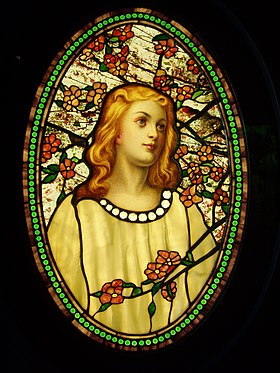
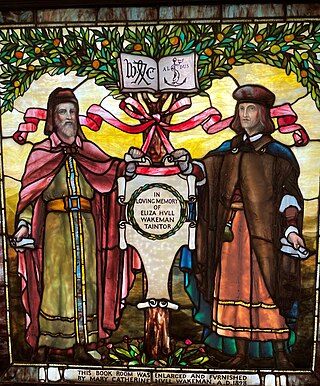
Tiffany glass refers to the many and varied types of glass developed and produced from 1878 to 1929–1930[1][2][3][4] at the Tiffany Studios in New York City, by Louis Comfort Tiffany and a team of other designers, including Clara Driscoll,[5][6] Agnes F. Northrop,[7] and Frederick Wilson.
In 1865, Tiffany traveled to Europe, and in London he visited the Victoria and Albert Museum, whose extensive collection of Roman and Syrian glass made a deep impression on him. He admired the coloration of medieval glass and was convinced that the quality of contemporary glass could be improved upon because the production of art glass in America during this time was not close to what Europeans were creating. In his own words, the "Rich tones are due in part to the use of pot metal full of impurities, and in part to the uneven thickness of the glass, but still more because the glass maker of that day abstained from the use of paint".
Tiffany was an interior designer, and in 1878 his interest turned toward the creation of stained glass, when he opened his own studio and glass foundry because he was unable to find the types of glass that he desired in interior decoration. His inventiveness both as a designer of windows and as a producer of the material with which to create them was to become renowned.[8] Tiffany wanted the glass itself to transmit texture and rich colors and he developed a type of glass he called "Favrile".
Tiffany Studios
[edit]The favrile, or "fabrile" glass was manufactured at the Tiffany factory located at 96–18 43rd Avenue in the Corona section of Queens[9] from 1901 to 1932. Today, the Louis Tiffany School or New York City's P.S. (public school) 110Q, is now built on the old site.[1]
Closing
[edit]The closing of the factory has been a matter of some controversy. Tiffany's glass fell out of favor in the 1910s, and by the 1920s a foundry had been installed for a separate bronze company. Tiffany's leadership and talent, as well as his father's money and old firm allowed Tiffany to relaunch Tiffany studios as a marketing strategy in order for his business to thrive. In 1932, Tiffany Studios filed for bankruptcy. Ownership of the complex passed back to the original owners of the factory — the Roman Bronze Works — which had served as a subcontractor to Tiffany for many years."[1][3][10] John Polachek, founder of the General Bronze Corporation —who had worked at the Tiffany Studios earlier— purchased the Roman Bronze Works (the old Tiffany Studios).[2][4] General Bronze then became the largest bronze fabricator in New York City formed through the merger of his own companies and Tiffany's Corona factory.[2][11][4] Louis Tiffany subsequently died in 1933.
Types
[edit]Opalescent glass
[edit]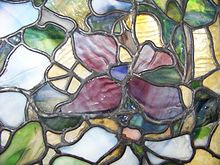
The term "opalescent glass" is commonly used to describe glass where more than one color is present, being fused during the manufacture, as against flashed glass in which two colors may be laminated, or silver stained glass where a solution of silver nitrate is superficially applied, turning red glass to orange and blue glass to green. Some opalescent glass was used by several stained glass studios in England from the 1860s and 1870s onwards, notably Heaton, Butler and Bayne. Its use became increasingly common. Opalescent glass is the basis for the range of glasses created by Tiffany.[notes 1]
In addition opalescent glass comes in three main types. The first type is exemplified by blue-tinged semi-opaque or clear glass with milky opalescence in the center, seen in creations by Lalique, Sabino, and Jobling's. This effect is achieved through slower cooling, causing crystallization. The glass glows golden when backlit and a beautiful blue when front-lit. Many French companies in the 1920s and 1930s, such as Lalique and Sabino, produced opalescent art deco pieces. The second type features a milky white edge or raised pattern on colored pressed glass. Reheating sections during the cooling process turns them white, creating a decorative effect. This method was employed by various companies, including Barolac in Bohemia, Joblings in England, and Val St Lambert in Belgium. The third type involves hand-blown glass with two layers, containing heat-reactive components like bone ash. The glass is blown into a mold with a raised pattern, and reheating turns the heat-sensitive glass milky white, creating a contrasting silhouette against the clear background (for more information [1]).
Favrile glass
[edit]
Tiffany patented Favrile glass in 1892. Favrile glass often has a distinctive characteristic that is common in some glass from Classical antiquity: it possesses a superficial iridescence. This iridescence causes the surface to shimmer, but also causes a degree of opacity. This iridescent effect of the glass was obtained by mixing different colors of glass together while hot.
Favrile glass is distinguished by brilliant or deeply toned colors, usually iridescent like the wings of certain American butterflies, the necks of pigeons and peacocks, the wing covers of various beetles.
Louis C. Tiffany
Streamer glass
[edit]
Streamer glass refers to a sheet of glass with a pattern of glass strings affixed to its surface. Tiffany made use of such textured glass to represent, for example, twigs, branches and grass. Streamers are prepared from very hot molten glass, gathered at the end of a punty (pontil) that is rapidly swung back and forth and stretched into long, thin strings that rapidly cool and harden. These hand-stretched streamers are pressed on the molten surface of sheet glass during the rolling process, and become permanently fused.
Fracture glass
[edit]
Fracture glass refers to a sheet of glass with a pattern of irregularly shaped, thin glass wafers affixed to its surface. Tiffany made use of such textured glass to represent, for example, foliage seen from a distance. The irregular glass wafers, called fractures, are prepared from very hot, colored molten glass, gathered at the end of a blowpipe. A large bubble is forcefully blown until the walls of the bubble rapidly stretch, cool and harden. The resulting glass bubble has paper-thin walls and is immediately shattered into shards. These hand blown shards are pressed on the surface of the molten glass sheet during the rolling process, to which they become permanently fused.
Fracture-streamer glass
[edit]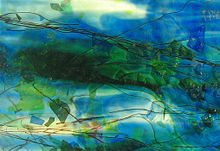
Fracture-streamer glass refers to a sheet of glass with a pattern of glass strings, and irregularly shaped, thin glass wafers, affixed to its surface. Tiffany made use of such textured glass to represent, for example, twigs, branches and grass, and distant foliage. The process is as above except that both streamers and fractures are applied to sheet glass during the rolling process.
Ring mottle glass
[edit]
Ring mottle glass refers to sheet glass with a pronounced mottle created by localized, heat-treated opacification and crystal-growth dynamics. Ring mottle glass was invented by Tiffany in the early 20th century. Tiffany's distinctive style exploited glass containing a variety of motifs such as those found in ring mottle glass, and he relied minimally on painted details.
When Tiffany Studio closed in 1929–1930,[3][1][2][4] the secret formula for making ring mottle glass was forgotten and lost. Ring mottle glass was re-discovered in the late sixties by Eric Lovell of Uroboros Glass.[12] Traditionally used for organic details on leaves and other natural elements, ring mottles also find a place in contemporary work when abstract patterns are desired.
Ripple glass
[edit]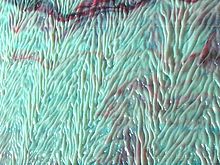
Ripple glass refers to textured glass with marked surface waves. Tiffany made use of such textured glass to represent, for example, water or leaf veins. The texture is created during the glass sheet-forming process. A sheet is formed from molten glass with a roller that spins on itself while travelling forward. Normally the roller spins at the same speed as its own forward motion, much like a steam roller flattening tarmac, and the resulting sheet has a smooth surface. In the manufacture of rippled glass, the roller spins faster than its own forward motion. The rippled effect is retained as the glass cools.
Drapery glass
[edit]
Drapery glass refers to a sheet of heavily folded glass that suggests fabric folds. Tiffany made abundant use of drapery glass in ecclesiastical stained glass windows to add a 3-dimensional effect to flowing robes and angel wings, and to imitate the natural coarseness of magnolia petals. The making of drapery glass requires skill and experience. A small diameter hand-held roller is manipulated forcefully over a sheet of molten glass to produce heavy ripples, while folding and creasing the entire sheet. The ripples become rigid and permanent as the glass cools. Each sheet produced from this artisanal process is unique.
Cutting techniques
[edit]In order to cut streamer, fracture or ripple glass, the sheet may be scored on the side without streamers, fractures or ripples with a carbide glass cutter, and broken at the score line with breaker-grozier pliers. In order to cut drapery glass, the sheet may be placed on styrofoam, scored with a carbide glass cutter, and broken at the score line with breaker-grozier pliers, but a bandsaw or ringsaw are the preferred.
Locations and collections
[edit]
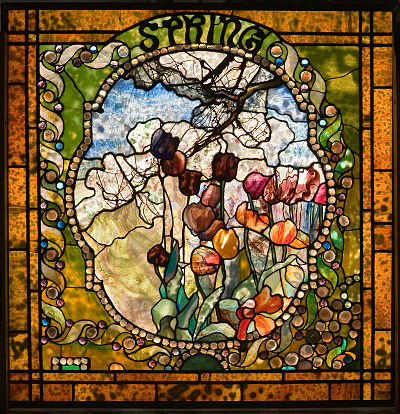

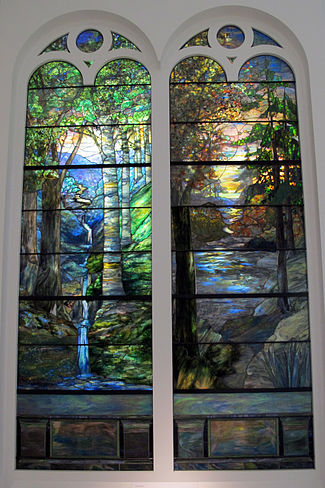
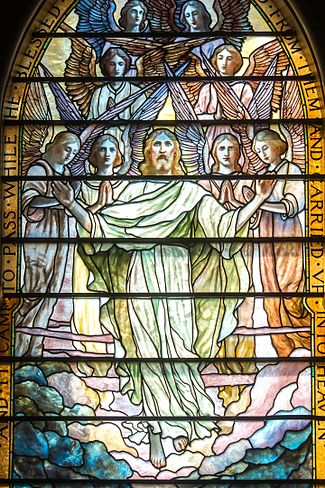
Stained glass in situ
[edit]- Canada
- Ontario
- London – St Paul's Cathedral, four windows, two signed by Tiffany
- Quebec
- Montreal – Montreal Museum of Fine Arts, Bourgie Pavilion (formerly Erskine and American United Church), twenty windows signed by Tiffany
- Ontario
- Mexico
- Scotland
- United States
- Alabama
- Arizona
- California
- Vallejo – St. Peter's Chapel, Mare Island, 25 windows by Tiffany[13]
- Colorado
- Colorado Springs – First United Methodist Church
- Connecticut
- Florida
- St. Augustine – Flagler College
- Georgia
- Atlanta – All Saints' Episcopal Church[16]
- Jekyll Island – Faith Chapel
- Macon – St. Paul's Episcopal Church
- Savannah – Gryphon Tea Room
- Thomasville – St. Thomas Episcopal Church
- Illinois
- Chicago –
- Macy's on State Street, formerly Marshall Field's
- Second Presbyterian Church on South Michigan Avenue
- Chicago Cultural Center
- Springfield – First Presbyterian Church
- Tinley Park – St. Andrew's Anglican Church[17]
- Chicago –
- Indiana
- Indianapolis – Second Presbyterian Church
- Richmond – Reid Center, formerly Reid Memorial Presbyterian Church
- Iowa
- Kansas
- Topeka – First Presbyterian Church
- Kentucky
- Louisiana
- Maine
- Maryland
- Massachusetts
- Boston –
- Wellesley – Houghton Memorial Chapel at Wellesley College
- Nantucket – St. Pauls Episcopal Church[22]
- Michigan
- Ann Arbor –
- Grand Rapids –
- Ladies Literary Club
- Temple Emanuel
- Marquette –
- The Resurrection Window, Morgan Chapel, St. Paul's Episcopal Church
- Minnesota
- Stillwater – Episcopal Church of the Ascension
- Mississippi
- University – Ventress Hall at The University of Mississippi Tribute to the University Greys[23]
- Missouri
- New Hampshire
- New Jersey
- Hackensack – Second Reformed Church
- Maplewood – Morrow Memorial United Methodist Church
- New Brunswick – Kirkpatrick Chapel at Rutgers, The State University of New Jersey[24][25]
- New York
- Albany – First Presbyterian Church of Albany[26]
- Albion – Pullman Memorial Universalist Church
- Auburn – Willard Chapel
- Bath – First Presbyterian Church
- Beacon – St. Andrew's Church [27]
- Briarcliff Manor – Congregational Church[28]
- Buffalo – St. Paul's Episcopal Cathedral [29]
- Irvington –
- Irvington Presbyterian Church
- Irvington Town Hall – Clock face and reading room
- Lockport – First Presbyterian Church[30]
- New York City –
- Brooklyn –
- Brown Memorial Baptist Church and church house[31]
- Flatbush Reformed Church and church house
- First Unitarian Congregational Society and Rev. Donald McKinney chapel
- Manhattan –
- Grand Central Terminal – 13-foot (4.0 m) clock face on south facade[32][33][34][disputed – discuss]
- West End Collegiate Church, West End Avenue
- St. Michael's Church, New York City, Amsterdam Avenue at 99th Street
- Holy Trinity Lutheran Church
- Brooklyn –
- Roslyn – Trinity Episcopal Church[35]
- Roxbury – Jay Gould Memorial Reformed Church
- Saugerties – St. Mary of the Snow, 36 Cedar Street
- Troy – Troy Public Library St. Joseph's Catholic Church – St. Paul's Episcopal Church
- Tuxedo Park – St. Mary's-in-Tuxedo Episcopal Church
- Garden City – St Paul's School, endangered glass[36][37]
- Washingtonville – Moffat Library
- Ohio
- Cleveland – Wade Memorial Chapel in Lake View Cemetery
- Dayton –
- Westminster Presbyterian Church, 125 N. Wilkinson Street[38][39]
- Historic Woodland Cemetery & Arboretum, 118 Woodland Avenue[40]
- Pennsylvania
- Altoona – St. Lukes Episcopal Church
- Brownsville – Christ Church
- Erie –
- Cathedral of St. Paul
- First Presbyterian Church
- Franklin – St. John's Episcopal Church
- Franklin – Christ's Church[41]
- Kittanning – Grace Presbyterian Church
- Lancaster – First Presbyterian Church
- Lewistown –
- St. Mark's Episcopal Church[42][failed verification]
- First United Methodist Church[43][failed verification]
- Montgomery Township – Robert Kennedy Memorial Presbyterian Church
- New Castle – St. Jude's Episcopal Church, formerly known as Trinity Episcopal Church
- Philadelphia –
- Pittsburgh –
- Calvary United Methodist Church[44]
- Emmanuel Episcopal Church
- Shadyside Presbyterian Church
- First Presbyterian Church
- Third Presbyterian Church
- St. Andrews Episcopal Church
- Sewickley –
- First Presbyterian Church
- St. Stephen's Episcopal Church
- Sharon – Buhl Mausoleum
- Titusville – St. James Memorial Episcopal Church
- Uniontown –
- Trinity United Presbyterian Church
- St. Peter's Anglican Church[45]
- Whitemarsh Township – St. Thomas' Church
- Williamsport – Christ Community Worship Center, formerly the Presbyterian Church of the Covenant
- Tennessee
- Texas
- Galveston – Trinity Episcopal Church[47]
- Houston – Christ Church Cathedral
- Utah
- Vermont
- St. Johnsbury – Grace United Methodist Church
- Virginia
- Newport News – St. Paul's Episcopal Church
- Norfolk – St. Paul's Episcopal Church
- Richmond – Congregation Beth Ahabah
- Petersburg – Blandford Church
- Staunton – Trinity Episcopal Church[50]
- Washington
- Wisconsin
Museums
[edit]- United Kingdom
- United States
See also
[edit]- Tiffany lamp
- Stained glass
- The Sunset Scene (Glass Window)
- Stained glass windows of Chartres Cathedral
- Tiffany & Co.
- Louis Comfort Tiffany
References
[edit]Informational notes
- ^ The use of the term opalescent is actually a misnomer. Opalescence actually refers to the quality of changing color under transmitted light, rather than the quality of having several colors present. A rare example of true opalescent glass is the Roman Lycurgus cup in the British Museum
- ^ Stage "curtain" which is a stained glass foldable panel created out of nearly a million pieces of iridescent colored glass by Tiffany's in New York.
Citations
- ^ a b c d "A Chronology of Louis C. Tiffany and Tiffany Studios". Tiffany Studios. Retrieved 17 December 2023.
- ^ a b c d Erler, Diana (19 August 1928). "Creating a New Bronze Age". The Brooklyn Daily Eagle. p. 75. Retrieved 28 December 2023.
- ^ a b c "Tiffany Studios". The Charles Hosmer Morse Museum of American Art. Retrieved 17 December 2023.
- ^ a b c d "BRONZE CORPORATION BUYS TIFFANY STUDIOS; John Polachek Again in Control of Metal Working Plant Which He Once Managed". No. Business & Finance. The New York Times Publishing. The New York Times. 31 January 1928. Retrieved 29 December 2023.
- ^ Taylor, Kate (February 13, 2007). "Tiffany's Secret Is Over". New York Sun. Retrieved 2009-11-16.
- ^ Kastner, Jeffrey (February 25, 2007). "Out of Tiffany's Shadow, a Woman of Light". The New York Times. Retrieved 2009-11-16.
- ^ a b McGreevy, Nora, Stunning Tiffany Stained Glass Debuts After 100 Years of Obscurity, Smithsonian Magazine, May 28, 2021
- ^ Lee, Lawrence; Seddon, George; Stephens, Francis (1976). Stained Glass. Spring Books. ISBN 0-600-56281-6.
- ^ Staff (June 14, 2013). "R.I.P. Tiffany Studios, Corona". Forgotten New York.
- ^ "Roman Bronze Works". Amon Carter Museum of American Art. Carter Museum. Retrieved 23 December 2023.
- ^ "John Polachek, An Industrialist" (PDF). The New York Times. Obituaries. 18 April 1955. p. 22. Retrieved 18 December 2023.
In 1903, he became a supervisor of bronze manufacturing for Tiffany Studios. Founder of General Bronze Corporation Dies – Products Adorn Leading Buildings
- ^ "Ring Mottle Opalescent Sheet Glass". Uroboros Glass. Uroboros Glass Studios, Inc. Retrieved July 19, 2017.
- ^ "Tiffany Census: St. Peter's Chapel, Mare Island, Vallejo, California". cambridge2000.com. Retrieved 20 August 2024.
- ^ "Tiffany Stained Glass Window". Center Church on the Green. Retrieved July 19, 2017.
- ^ "Architecture & History". Trinity Lutheran Church. 2004.
A lavish stained glass window by Louis Comfort Tiffany, which pictures Jesus and a young child, was installed in 1916.
- ^ "Campus". All Saints' Episcopal Church. Retrieved July 19, 2017.
When entering the church nave, a visitor is struck by the vibrancy of the red apse and the stained glass windows. Six of the nave and chapel windows were crafted by Tiffany studios. Windows in the chapel depict the creation story over the altar and scenes from the lives of biblical and contemporary saints on the side walls.
- ^ "Christ Reformed Episcopal Church, Chicago, Illinois". Tiffany Census. Cambridge 2000. p. 13.1.1. Retrieved 20 November 2023.
- ^ "Methodist History: Tiffany Church Windows". The United Methodist Church. April 19, 2017. Retrieved July 19, 2017.
- ^ "History". Trinity Episcopal Church, Covington, Kentucky. Trinity Episcopal Church of Covington Kentucky. Retrieved July 19, 2017.
Added to the National Register of Historic Places in 1982, Trinity contains a number of important works of art, including stained glass windows designed by the John Riordan Studio of Cincinnati as well as the St. Michael Archangel window created by the Louis Tiffany studio of New York.
- ^ Duplessis Jasmin, Alicia (July 19, 2016). "Tiffany windows are Tulane treasure". Tulane University News. Tulane University.
- ^ "Our History". The Portland Masonic. Retrieved 2022-06-09.
- ^ "Our Stained Glass Windows | St. Paul's Church | Nantucket". stpaulschurchnantucket.org. Retrieved 2019-10-18.
- ^ "University Greys Memorial Window Contextualization Plaque Text". libarts.olemiss.edu. Retrieved 2023-04-11.
- ^ "Stained Glass Windows". Rutgers – Kirkpatrick Chapel. Rutgers, The State University of New Jersey. Archived from the original on 21 October 2013. Retrieved 2 September 2013.
- ^ Di Ionno, Mark (8 August 2012). "Di Ionno: At historic Rutgers chapel, stained glass is still shining". The Star-Ledger. New Brunswick, New Jersey. Retrieved 2 September 2013.
- ^ O'Toole, Tim. "For a Closer Look". Our Windows. First Presbyterian Church of Albany. Retrieved July 19, 2017.
- ^ Murphy, Robert (April 7, 2018). "Opalescent Stained Glass at St. Andrew's Church". Beacon Historical Society. Retrieved May 17, 2018.
- ^ Sharman, Karen M., ed. (1996), Glory in Glass: A Celebration of the Briarcliff Congregational Church, Briarcliff, New York: privately printed
- ^ Clemens, Chris (June 25, 2014). "Taking an Inside Tour of St. Paul's Episcopal Cathedral in Downtown Buffalo". Exploring Upstate. Retrieved July 25, 2021.
- ^ "Tiffany Windows". First Presbyterian Church. Retrieved June 13, 2016.
- ^ Rasheed, Tara (May 18, 2012). "Brown Memorial Baptist Church, Brooklyn". Untapped Cities.
- ^ Swidler, Kim Stuart (August 29, 2012). "Secrets of NYC's Grand Central Terminal: Outdoor Tiffany Clock Up Close". The Times Union. Albany, New York. Retrieved June 23, 2017.
- ^ Staff (ndg) "What to See: Tiffany Clock & Park Avenue Viaduct" Grand Central Terminal official website
- ^ Young, Michelle (October 15, 2014) "Inside the World's Largest Tiffany Clock at Grand Central Terminal" Untapped New York
- ^ "Trinity Church History". Trinity Episcopal Church. Retrieved July 19, 2017.
- ^ Rikki N. Massand (7 September 2018). "Preservationists criticize St. Paul's concept". Garden City News. Retrieved October 20, 2019.
- ^ Rob Alvey (November 28, 2008). "Tiffany Studio Window At St. Paul's Confirmed". Garden City News.
- ^ "Te Deum Window". Westminster Presbyterian Church. Retrieved 10 August 2015.
- ^ "Te Deum Window" (PDF). Dayton, Ohio: Westminster Presbyterian Church. Retrieved 10 August 2015.
- ^ Campbell, Charlie (May 30, 2013). "Woodland Cemetery & Arboretum". Dayton Convention & Visitors Bureau. Retrieved 10 August 2015.
- ^ Himler, Jeff (July 25, 2022). "Christ's Church of Greensburg looks to future, holds on to tradition as bicentennial approaches". TribLIVE. Retrieved January 5, 2024.
- ^ "You're Welcome". St. Mark's Episcopal Church.
- ^ "Welcome". Lewistown First United Methodist Church.
- ^ "History and Architecture" Calvary United Methodist Church]
- ^ "Uniontown Downtown Historic District Nomination Form". National Register of Historic Places. Retrieved January 5, 2024.
- ^ "A BRIEF HISTORY OF THE BASILICA". The Basilica of Sts. Peter & Paul. Retrieved July 19, 2017.
- ^ "The Beginning". Trinity Episcopal Church. Retrieved July 19, 2017.
The sanctuary of Trinity church boasts 20 stained glass windows, some priceless, including two made by Tiffany Studios of New York.... The great window over the altar depicting Christ as the protector of "the least of these, my brethren" was designed and made by Louis Comfort Tiffany of New York in 1904 in memory of George and Magnolia Sealy and is one of the rarest of its kind due its size, age and the fact that it remained intact and unbroken through many natural disasters.
- ^ a b Joyce Athay Janetski, "Louis Comfort Tiffany: Stained Glass in Utah," Utah Preservation/Restoration: A Publication for the Preservationist, vol. 3 (1981), pp. 20–25.
- ^ Joyce Athay Janetski, "Stained Glass Windows: A Latter-day Saint Legacy", Ensign, January 1981, pp. 34–41.
- ^ "Visiting". Trinity Episcopal Church, Staunton, Virginia. Trinity Episcopal Church. 21 June 2013. Retrieved July 19, 2017.
Tourists are particularly interested in the stained-glass, including 12 Tiffany windows which span Louis Comfort Tiffany's 40-year career.
- ^ "Permanent Exhibitions: Tiffany Treasures". Oshkosh Public Museum. Oshkosh Public Museum. Retrieved July 19, 2017.
- ^ "Haworth Art Gallery, Accrington". Hyndburn – The place to be – an excellent council. Hyndburn Borough Council. Retrieved July 19, 2017.
Come and visit the Haworth Art Gallery and see for yourself the world-famous Tiffany glass collection – the largest public collection in Europe. Free admission gives you access to 4 rooms dedicated to the collection, see fine examples of Louis Comfort Tiffany's Favrile glass vases, mosaics, and tiles in both static and interactive exhibits.
- ^ "Welcome to the Morse Museum". The Charles Hosmer Morse Museum of American Art. Charles Hosmer Morse Foundation, Inc. 2016.
The Morse Museum houses the world's most comprehensive collection of works by Louis Comfort Tiffany (1848–1933), including the artist and designer's jewelry, pottery, paintings, art glass, leaded-glass lamps and windows; his chapel interior from the 1893 World's Columbian Exposition in Chicago; and art and architectural objects from his Long Island country estate, Laurelton Hall.
- ^ Naylor, Donita (21 February 2020). "Tiffany church window, unnoticed in Providence, will be a star attraction in Chicago art museum". The Providence Journal. Archived from the original on 23 February 2020. Retrieved 23 February 2020.
- ^ Kahn, Eve M. (7 July 2016). "Magnificent Obsession Morphs into a Stained-Glass Museum". The New York Times. Retrieved 2018-09-15.
- ^ "Tiffany Windows". Newcomb Art Museum of Tulane. Newcomb Art Museum. Retrieved July 19, 2017.
- ^ "Meadow Brook Hall History | Rochester, MI". Meadow Brook Hall. Retrieved 2024-04-16.
- ^ "Exchange|Search: artist:"Louis Comfort Tiffany"". exchange.umma.umich.edu. Retrieved 2020-05-05.
- ^ "Experience Tiffany Glass". The Neustadt. Retrieved July 19, 2017.
- ^ "Landscape Window". New-York Historical Society Museum & Library. New-York Historical Society. Retrieved 17 December 2012.
- ^ "Tri-Fold Screen". Collections. Virginia Museum of Fine Arts. 2000. Retrieved July 19, 2017.
- ^ "Ornamental Hair Comb". Collections. Virginia Museum of Fine Arts. 2012. Retrieved July 19, 2017.
Further reading
- Eidelberg, Dr. Martin (2007). Tiffany Favrile Glass and the Quest of Beauty. New York: Lillian Nassau LLC. ISBN 978-0-615-16761-9.
- Frelinghuysen, Alice Cooney (2006). Louis Comfort Tiffany and Laurelton Hall: an artist's country estate. New York: The Metropolitan Museum of Art. ISBN 1588392015.
External links
[edit]- Publications and ephemeral materials from Tiffany Studios, Tiffany Glass & Decorating Company, Tiffany and Company, and the Louis Comfort Tiffany Foundation – held by the Metropolitan Museum of Art
